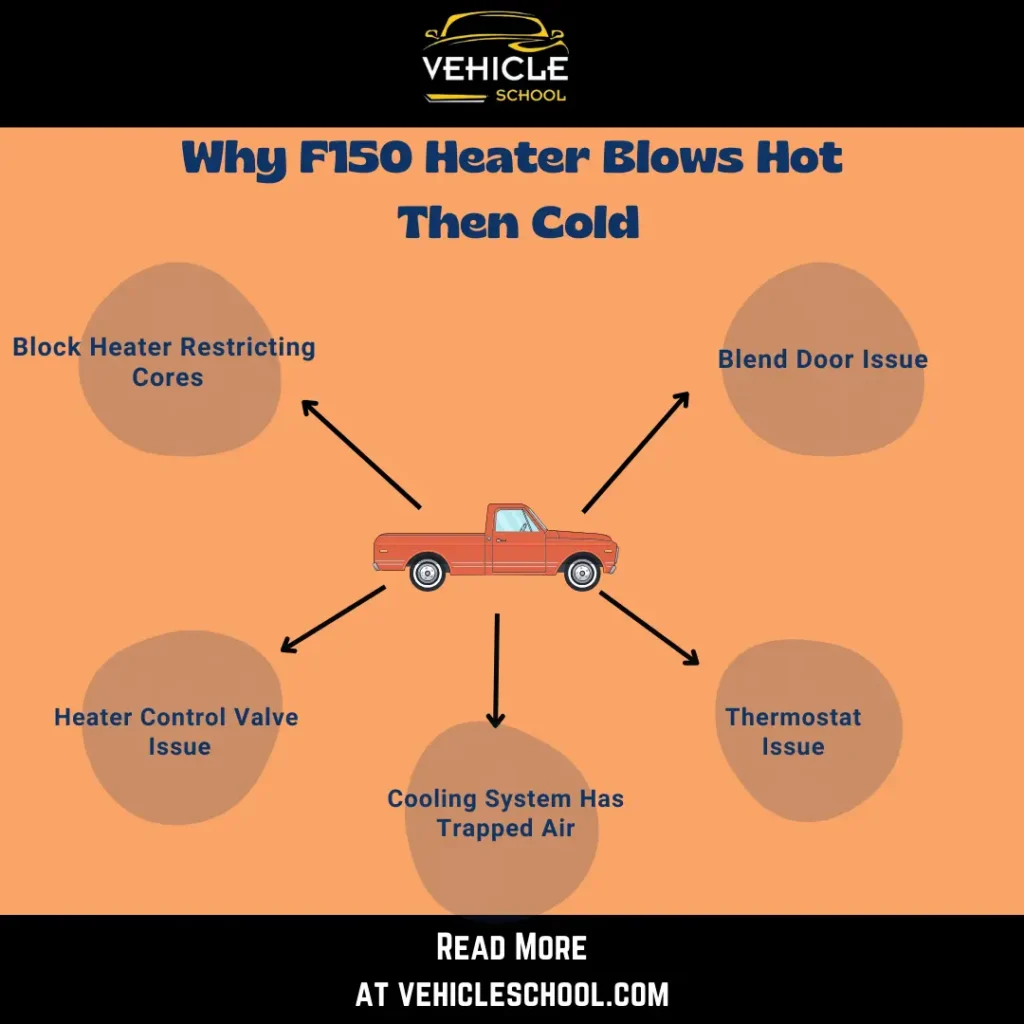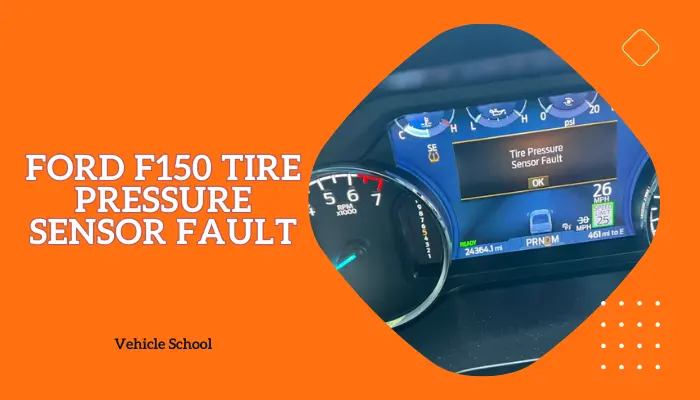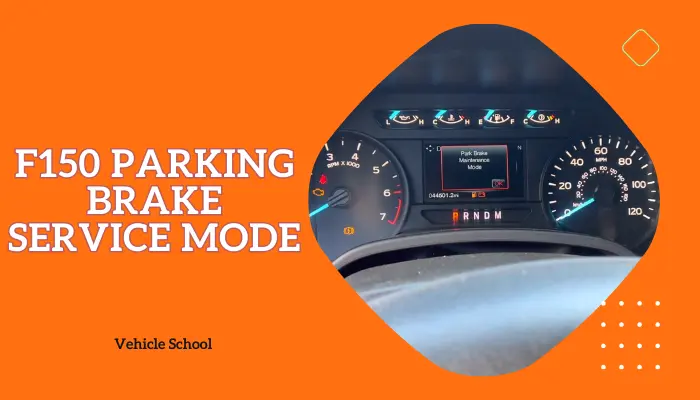The heater in my F150 has been acting up lately. One minute, I’m toasty warm, and the next, I’m shivering as cold air blows through. It’s been bugging me for a while now, and I’m not alone. People have been talking about this issue since way back in 2013 and 2015, sharing their frustrations on forums.
In this article, I’ll share the solutions I’ve found to tackle this problem.
Why Is Ford F150 Heater Blowing Cold Air?
Ford F-150’s heater blows cold air due to problems with the blend door actuator, thermostat, blocked heater, control valve, trapped air, or water pump.
In this section, I’ll go through all the reasons in detail first.

1. The Blend Door Actuator Is Faulty
A malfunctioning blend door actuator can impact the whole climate control system. It regulates the mix of hot and cold air.
Issues like gearbox malfunctions or a broken cam can cause trouble. Look for the motor beneath the dashboard near the radio for inspection. You should also consider performing f150 blend door actuator reset before trying to fix it.
According to Ford, this is common in 2015–2019 F-150s. If you notice the F150 AC not blowing cold, then you can be certain it’s a faulty blend door actuator.
2. The Thermostat Is Broken
If your F150’s heater is blowing hot then cold, it could be a faulty thermostat. A glitch in its operation, like getting stuck open and suddenly closing, disrupts coolant flow.
This causes the heater to go from hot to cold, and if the temperature gauge spikes, leading to overheating, then that means you’re experiencing this issue.
3. Block Heater Restricting Cores
Uneven heating may be due to restricted heater cores, often linked to prolonged block heater use.
Check the heater core lines when the truck is warm; both should be hot for proper flow.
If there’s a restriction, it mainly affects the heater, causing inconsistent performance inside the cabin. There’s a TSB for this issue.
4. Problem With The Heater Control Valve
For such irregular heater behavior, the heater control valve might also be to blame.
This valve controls the flow of hot coolant to the heater core, and any malfunction can disrupt consistent warm air delivery to the cabin.
5. There’s Trapped Air In The Cooling System
Inconsistent heating may also be caused by air trapped in the cooling system, often aggravated by improper antifreeze application.
Air pockets disrupt the smooth flow of coolant, leading to temperature variations from the heater.
How To Fix Ford F150 Heater Blowing Cold Air?
You can fix the heater in your F150 by replacing the faulty parts, draining and replacing the thermostat, unblocking the heater, tapping or replacing the control valve, removing air pockets, or replacing the water pump.
Here are the step-by-step processes you can follow to fix this issue.
1. Fix The Blend Door Actuator
- Remove panels to access the actuator.
- Inspect and document damaged gear.
- Replace the broken gear.
- Reassemble, align gears, and tighten screws.
- Test actuator movement for smooth operation.
- If replacing the entire actuator, detach and inspect.
- Remove the old actuator, align it, and secure the new one.
- Connect the wiring and reinstall the components.
- Test the HVAC system thoroughly for smooth operation.
This fix is also applicable if your F150’s rear defroster is not working to its full potential due to insufficient circulation of warm air.
2. Resolve Thermostat Issue
There are two sets of fixes for this. One set is for older Fords, and the other is for modern ones.
I’ll add a gist of both processes, but if you notice the symptoms of this, then you might want to dig deeper into the thermostat issue of your F-150.
For Old Models (Pre 2005):
- Drain radiator, cool engine.
- Loosen and shift the air intake hose.
- Disconnect the vacuum hose and remove the covers.
- Unhook hoses below the air intake.
- Use tools to remove the hose clamps.
- Extract the old thermostat.
- Get a new thermostat, gasket, scraper, and sealant.
- Scrape off old gasket material.
- Apply sealant, and place the new thermostat in the block.
- Reconnect and secure hoses.
- Ensure snug housing fit, refill radiator.
- Start the engine, and check for coolant leaks.
For New Models (2008-2017 )
- Park and cool the engine.
- Drain coolant, disconnect hoses, remove belts, and clean the air intake.
- Take off the lower radiator hose, spring clamp, and bolts from the coolant inlet.
- Extract the old thermostat and o-ring.
- Lubricate and put in the new o-ring and thermostat, reconnect the housing and tighten bolts.
- Reattach the lower radiator hose and reinstall the hose clamp.
- Rinse the coolant and loop the belt over the pulleys securely.
- Put back the air cleaner outlet tube.
- Fill the coolant and warm up with the heater when the truck starts.
- Check for warm air, add coolant if needed, and close the hood.
Here’s a demonstration from one of the best Ford experts I know:
3. Fix The Block Heater
- Monitor temperatures; if it’s -15°C (0°F) or lower, proceed.
- Before starting, plug in the block heater for 1-2 hours to warm up the engine.
- After block heater use, start the engine for smoother coolant flow.
- With the engine warm, touch the heater core lines. Both should be hot, indicating good flow.
- If needed, perform a coolant flush to clear any deposits causing restrictions.
- Make sure that the anti-freeze is applied correctly.
4. Fix The Heater Control Valve
You can usually fix this by giving the Heater Control Valve some taps. If that doesn’t work, you might need to do a full swap. Here’s how to do that:
- Locate the heater valve, PCB hose, and vacuum tube.
- Ensure the engine is cool.
- Move the PCB hose locking mechanism.
- Unscrew the clamps on PCB hose.
- Disconnect the vacuum tube.
- Undo clips on radiator hoses.
- Remove the old valve and install a new one.
- Reattach radiator hoses, vacuum tube, and secure connections.
- Heat the truck in heater mode.
- Ensure the valve works without leaks.
- Monitor fluid levels and refill the reservoir if needed.
- Tighten remaining connections or clamps.
Here’s a quick and easy demonstration of the same thing:
5. Remove Air Pockets From Cooling System
- Ensure the engine is cool.
- Start the engine and let it idle for 30 seconds.
- Rev the engine to 3,000 rpm for 30 seconds.
- Allow the engine to idle for another 30 seconds.
- Turn off the engine and wait for 1 minute.
- Perform the above cycle two more times for a total of three cycles.
- Start the engine again and allow it to reach the operating temperature.
- Turn on the heat once the operating temperature is reached.
- Confirm consistent and hot air flow from the heater.
Capping It All
It’s all about the basics: blend doors, heater cores, and thermostats.
With these fixes, you’re good to go, ensuring your drives are more cozy and there are fewer temperature shifts.
And that’s a wrap on fixing your F150’s heater issues.






